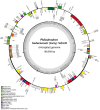The complete chloroplast genome of Philodendron hederaceum (Jacq.) Schott 1829 (Alismatales: Araceae)
- PMID: 38348093
- PMCID: PMC10860476
- DOI: 10.1080/23802359.2024.2311748
The complete chloroplast genome of Philodendron hederaceum (Jacq.) Schott 1829 (Alismatales: Araceae)
Abstract
Philodendron hederaceum (Jacq.) Schott 1829, a species of the Araceae family, is a foliage plant of ornamental value. The complete chloroplast genome sequence of Philodendron hederaceum was obtained by the de novo assembly of NovaSeq 6000 (Illumina Co., San Diego, CA) paired-end short reads and Oxford Nanopore long reads. The complete chloroplast genome of P. hederaceum was 168,609 bp in length, with a large single-copy (LSC) region of 94,393 bp, a small single-copy (SSC) region of 25,774 bp, and a pair of identical inverted repeat regions (IRs) of 24,221 bp. The genome contained a total of 129 genes, including 85 protein-coding genes, 36 transfer RNA (tRNA) genes, and eight ribosomal RNA (rRNA) genes. The phylogenetic analysis of P. hederaceum with 19 related species and two outgroup species revealed the closest taxonomical relationship with Philodendron lanceolatum in the Araceae family.
Keywords: Araceae; Oxford Nanopore sequencing; Philodendron hederaceum; complete chloroplast genome; next-generation sequencing.
© 2024 The Author(s). Published by Informa UK Limited, trading as Taylor & Francis Group.
Conflict of interest statement
No potential conflict of interest was reported by the author(s).
Figures



Similar articles
-
The complete chloroplast genome of Typhonium giganteum (Araceae).Mitochondrial DNA B Resour. 2020 Jul 25;5(3):2994-2995. doi: 10.1080/23802359.2020.1797571. Mitochondrial DNA B Resour. 2020. PMID: 33458030 Free PMC article.
-
The complete chloroplast genome of Echeveria lilacina Kimnach & Moran 1980 (Saxifragales: Crassulaceae).Mitochondrial DNA B Resour. 2022 May 26;7(5):889-891. doi: 10.1080/23802359.2022.2077668. eCollection 2022. Mitochondrial DNA B Resour. 2022. PMID: 35692710 Free PMC article.
-
The complete chloroplast genome of Caltha Palustris (Ranunculaceae).Mitochondrial DNA B Resour. 2018 Oct 3;3(2):1090-1091. doi: 10.1080/23802359.2018.1508383. Mitochondrial DNA B Resour. 2018. PMID: 33474427 Free PMC article.
-
The complete chloroplast genome of Sinomenium acutum (Menispermaceae).Mitochondrial DNA B Resour. 2020 Jul 25;5(3):2992-2993. doi: 10.1080/23802359.2020.1797570. Mitochondrial DNA B Resour. 2020. PMID: 33458029 Free PMC article.
-
Complete chloroplast genome of Gypsophila oldhamiana Miq. (Caryophyllales: Caryophyllaceae).Mitochondrial DNA B Resour. 2021 Nov 10;6(12):3381-3382. doi: 10.1080/23802359.2021.1997126. eCollection 2021. Mitochondrial DNA B Resour. 2021. PMID: 34778559 Free PMC article.
Cited by
-
Complete chloroplast genome and phylogenetic analysis of Amorphophallus paeoniifolius (Araceae).Mitochondrial DNA B Resour. 2024 Jul 13;9(7):865-870. doi: 10.1080/23802359.2024.2378966. eCollection 2024. Mitochondrial DNA B Resour. 2024. PMID: 39010881 Free PMC article.
References
-
- Boyce PC, Croat TB.. 2018. The Überlist of Araceae, totals for published and estimated number of species in aroid genera (140601uberlist-fixed.xlsx (aroid.org)).
-
- Coelho MAN, Soares ML, Calazans LSB, Gonçalves EG, Andrade IMd, Pontes TA, Sakuragui CM, Temponi LG, Buturi C, Mayo S.. 2016. Araceae in Lista de Espécies da Flora do Brasil. Rio De Janeiro: jardim Botânico Do Rio De Janeiro. Rodriguesia. 70(2). doi:10.1590/2175-7860201970042. - DOI
-
- Coelho MAN. 2000. Philodendron Schott (Araceae): morfologia e taxonomia das espécies da Reserva Ecológica de Macaé de Cima – Nova Friburgo, Rio de Janeiro, Brasil. Rodriguesia. 51(78–79):21–68. doi:10.1590/2175-7860200051787902. - DOI
LinkOut - more resources
Full Text Sources
Other Literature Sources
